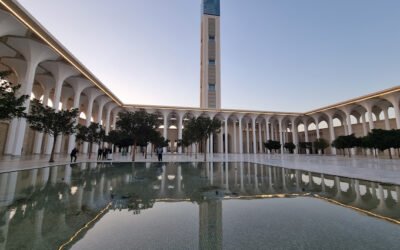Sidi Okba Mosque
Sidi Okba Mosque
- Sidi Okba Mosque (Arabic: مسجد سيدي عقبة, Musjid Sayyidi ʻUqbah) is a historic Musjid in Algeria, located in the village of Sidi Okba, near Biskra. The mausoleum was first established in 686 to house the remains of Uqba ibn Nafi (Radiyallaahu ‘Anhu), a companion of Rasoolullaah Sallallaahu Alayhi wa Sallam and one of the prominent commanders of the Muslim conquest of the Maghrib, making it one of the oldest Muslim monuments in Algeria. The Musjid was built around the tomb and has been renovated many times over the centuries.
- The Musjid is located in the locality of Sidi Okba, 6 km south of the town of Tabuda and 10 km west of the city of Biskra, on National Road number 38 toward the locality of Khenguet Sidi Nadjil.
- ʻUqbah ibn Nāfiʻ Radiyallaahu ‘Anhu, on his return from the victorious Battle of Vescera in the Atlas Mountains, was killed by the army of the Berber Christian king Kusayla ibn Lamzah in an ambush outside the town of Thouda in 683. He was buried in the current village of Sidi Okba, and later the Musjid was built on top of it for commemoration. It is not exactly recorded who built the Musjid. Some believe it was the followers of Uqba (Radiyallaahu ‘Anhu) who were captured during the battle and later redeemed by judges in Tunis from prison. Commander Zuhayr ibn Qays sent them back along with other Muslims to Thouda, where they built the Musjid.
- The building was not constructed all at once and was likely remodeled and expanded several times. The tomb, the oldest part, probably dates to 686, making it one of the first known Muslim monuments in Algeria. The decorated cedar-wood doors of the tomb have been dated by Georges Marçais to the first half of the 11th century (circa 1025) during the Zirid period, based on a stylistic comparison with Zirid woodwork in the Great Mosque of Kairouan and with contemporary inscriptions on stelae found in Tunisia. This likely indicates a major renovation at that time.
- A zawiya was added to the Musjid in 1665. Other inscriptions found in the Musjid likely indicate the dates of further repairs or expansions. One inscription dates the Musjid’s mihrab to 1214 AH (1799 AD) and another inscription on a wooden plaque gives the year 1215 AH (1800 AD). These inscriptions also name Muhammad ibn ‘Umar al-Tunisi as the sponsor of the work.


